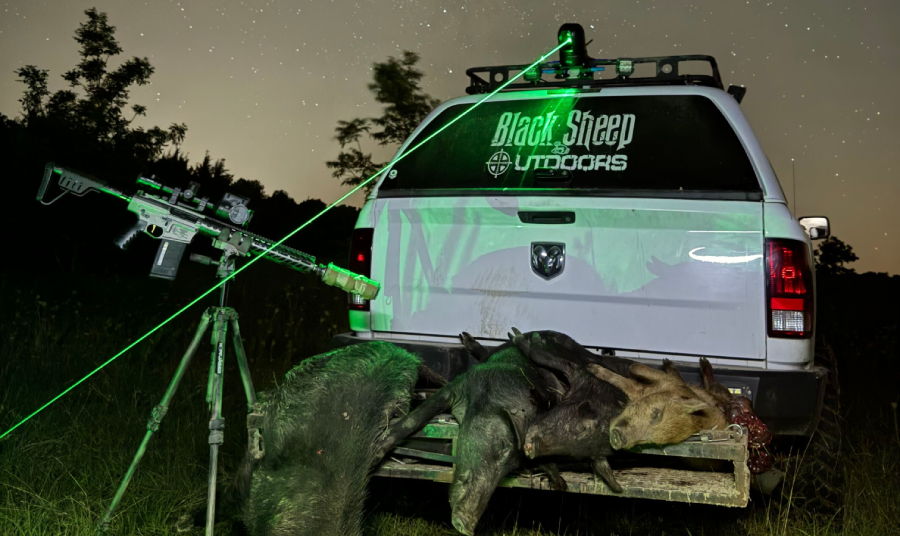Photo by Mitchell Graf
One of the most persistent myths in the night vision/thermal optics world is the belief that an infrared (IR) laser can be used with a thermal imaging scope to assist in aiming. While IR lasers are usually used for precision aiming with night vision devices, they serve no purpose with thermal optics due to the fundamental differences in how these technologies operate.
Why Thermal Scopes Can’t See IR Lasers
Thermal imaging technology works by detecting the heat emitted by objects in the environment, which is typically in the mid-wave (MWIR) or long-wave infrared (LWIR) spectrum. This heat is radiated naturally by everything around us, from warm-blooded animals to the cool air. Thermal scopes render a heat signature as a visual image, highlighting contrasts in temperature rather than visible or near-infrared light.
In contrast, IR lasers emit light in the near-infrared spectrum, typically around 850 nm to 950 nm. This wavelength is outside the range of what a thermal sensor can detect. Since thermal devices are not sensitive to light in the near-infrared spectrum, an IR laser’s beam or dot will be invisible to a thermal scope.
Night vision devices, on the other hand, amplify light—including near-infrared light from an IR laser—making it possible to see the beam. This is why IR lasers are compatible with night vision but not thermal imaging.
Alternatives to IR Lasers for Thermal Scopes
While IR lasers won’t work with thermal optics, there are effective alternatives for precise aiming:
- Thermal Reticles
Thermal scopes, like the Pulsar Thermion 2 series, come equipped with built-in customizable reticles that can be zeroed to your firearm. These reticles appear as part of the digital image on your scope’s display, providing a precise point of aim.
- Visible Lasers
For users who prefer an external aiming aid, a visible laser in the red or green spectrum can complement a thermal scope. Although these lasers are visible to the naked eye and won’t affect the thermal image, they can be used for short-range engagements or quick target acquisition.
- Picture-in-Picture Mode
Some Pulsar thermal scopes feature a picture-in-picture (PiP) mode, which provides a magnified view of the reticle while maintaining a wide field of view. This feature enhances accuracy without the need for external devices.
- Precision Mounts and Rail Systems
Using a precision-mounted thermal scope ensures stability and consistent point-of-aim. Accessories like rail-mounted backup sights or quick-detach mounts can also enhance versatility in the field.
It’s also worth noting that red or green visible light lasers won’t work as aiming aids for thermal optics either. Just like IR lasers, these emit light—not heat—and are therefore outside the detection range of a thermal scope. Thermal devices are designed to detect temperature differences, not light wavelengths, so while visible lasers might provide a visual reference to the naked eye, they won’t show up through your thermal scope.
While a green laser is not visible through a thermal scope, it can still have utility in certain scenarios, such as identifying downed targets or marking points of interest for others in your group. A green laser is highly visible to the naked eye, especially in low-light conditions, making it useful for communicating target locations or verifying successful hits without relying on thermal imaging alone. However, this application is limited to situations where the laser's visibility to others does not compromise stealth, as the beam can be easily seen by both teammates and potential adversaries.
Recommended Thermal Scope
For hunters and tactical professionals seeking the best in thermal performance, the Pulsar Thermion 2 LRF XL50 is an excellent choice. This scope delivers crisp imagery, thanks to its high-resolution sensor and advanced software, and it offers features like PiP mode, multiple reticle options, and one-shot zeroing for precise adjustments.
The Thermion 2 LRF XL50 is also rugged and reliable, with a magnesium alloy housing and an IPX7 waterproof rating, ensuring it performs in the harshest conditions. Its advanced features and durable design make it the ideal solution for those who want unparalleled accuracy without relying on IR lasers.
While IR lasers are naturally paired with night vision devices, they are ineffective with thermal imaging due to their emission in a wavelength undetectable by thermal sensors. With alternatives like built-in thermal reticles, visible lasers, and advanced features like PiP, thermal users can achieve precision aiming without compromise.
If our products have helped you in any way, share your story with us! Accepted stories will receive a 20% discount code.






1 comment
Looking for a thermal night vision